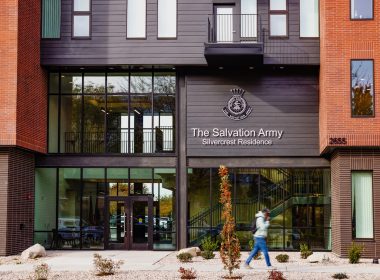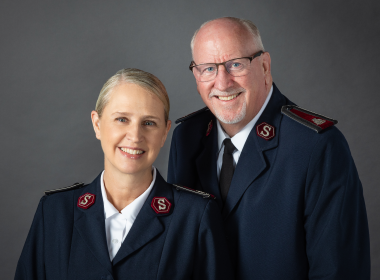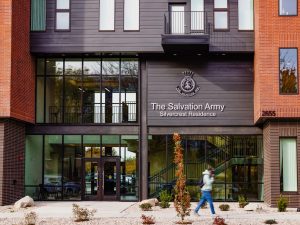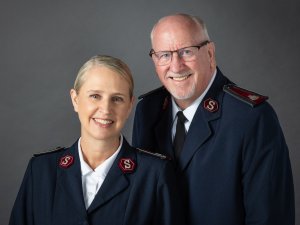The Salvation Army transitions to long-range recovery phase of disaster relief.
by Ron Busroe, Major –
The 7.1 magnitude earthquake of Jan. 12, 2010, damaged or destroyed half the homes in Port-au-Prince, Haiti’s capital city, leaving 300,000 people dead and 1½ million homeless. Estimates run as high as 200,000 amputations since the earthquake.
When the disaster struck, The Salvation Army immediately got to work—helping people and creating order from chaos. Today, the Army is still in Haiti, initiating long-range recovery plans, looking to help Haitians build a brighter future.
Around the world, Salvationists and friends responded generously with funds and personnel. During the emergency phase hundreds of volunteers and active officers worked tirelessly to provide for the immediate needs of the people. Doctors and nurses from the U.S. worked in difficult conditions to provide emergency medical aid to affected people. Food, water and shelter have been a major concern. The Salvation Army has managed a displaced persons’ camp with a population of over 20,000 located just behind the existing Salvation Army compound.
Long-term recovery phase begins
As the emergency relief effort continues, International Headquarters—in an effort to provide for orderly transition to long-term recovery—established a Haiti support desk in London with Lt. Colonel Heidi Bailey as director.
In Haiti, an Office of Recovery and Development (HRD) has opened with Major Ron Busroe as director. Also serving are Major Carol Busroe, project coordinator; Major Jean Volet, construction officer; Major Christine Volet, program manager; Majors Robert and Rae Doliber, finance officers; and Captains Monael and Lucie Many, spiritual and emotional support officers. The Volets’ 13-year-old son, Matthew, and the Manys’ 2-year-old son, Monael, round out the HRD team.
Major Lucien Lamartiniere, Haiti divisional commander said, “The Salvation Army world has opened its hands and hearts to the people of Haiti. We cannot say thank you enough for all that has been done to help lessen the terrible sufferings of the people.”
Current projects
Even though the Recovery Office officially opened September 1, a number of projects are already underway.
The U.S. Western Territory funded the purchase of a new divisional headquarters, housing the largest Salvation Army program in the western hemisphere outside the U.S. and Canada. The U.S. Southern Territory funded the rebuilding of the Port-au-Prince (PAP) Central Corps, the largest corps in the western hemisphere with over 500 senior soldiers and over 500 junior soldiers. Not one Sunday worship service was canceled because of the earthquake. About 1,000 people gather at 8 a.m. each Sunday in the tarp-covered schoolyard. Majors Jean Hubert and Magalie Murat, corps officers, report over 300 conversions since the earthquake with 59 enrolled as soldiers. Discipleship classes for these new converts continue.
Ten for Haiti is the project initiated by the U.S. Southern Territory to fund the PAP Central Corps rebuilding. If 5,000 soldiers commit to $10 per month for 24 months a new corps facility with a 4,000-seat capacity will become a reality. For more information go to
With school scheduled to re-open October 4, temporary classrooms are under construction at Fort Nationale and College Verena, the two Salvation Army schools located in some of the worst slums and hardest hit areas of the capital. Almost 1,700 students are looking forward to returning to school. A generous German donor committed to rebuild these schools under the direction of Kindernoltife, a child sponsorship agency supporting The Salvation Army in Haiti for over 35 years.
Major Jean Volet, construction manager, is coordinating the renovation of an additional 40 Salvation Army schools in Haiti through the generous support of the Salvation Army Netherlands.
Major Christine Volet, program manager for emotional and social support to young people affected by the disaster, is working closely with the divisional staff. Funding this program are the Swiss Salvation Army and other partners in Switzerland. The intention of these projects is to enhance services outside the directly affected areas to encourage those who have relocated to remain in the rural areas.
Over the next few months visits by Salvation Army development representatives from around the world will finalize projects that will place the Army at the forefront in helping to rebuild not only buildings but also, more importantly, the lives of the Haitian people.
Please remember to pray for the people of Haiti, the officers of Haiti and the recovery team that has come alongside to help.










